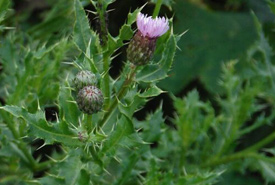
Canada thistle (Photo by NCC)
Canada thistle
Despite its name, this invasive thistle is not from Canada. It is believed to have come from the eastern Mediterranean region and was likely one of the first weeds that early settlers imported to North America.
The plant was called “Canada” thistle because early New England residents blamed its emergence on French traders from Canada. However, historians believe it appeared in the United States and Canada at approximately the same time. Its alternative name, creeping thistle, is more apt.
How is it identified?
Canada thistle can grow up to two metres tall at maturity. It has purple flowers and spiny, glossy leaves arranged alternately along its stem and many branches.
How does it grow?
This perennial plant reproduces primarily through horizontal roots or by seed. The former reproductive method is typically more successful and faster than the latter. Because of this, efforts to control Canada thistle populations focus primarily on horizontal roots.
Horizontal root shoots start emerging from the soil around the middle of April, and continue to do so during the summer. Seeds germinate beginning in late May through to autumn. A single plant can produce approximately 1,000 to 1,500 seeds, which are mainly dispersed by wind, but can also be spread by animals, equipment, clothing, water and vehicles.
Where does it grow?
Canada thistle is found in all Canadian provinces, as well as the Yukon and Northwest Territories. It typically grows in open areas, including pastures, cultivated fields, logged forests, riverbanks and roadsides. The plant does not tolerate very wet locations, and thrives on direct sunlight.
What does it threaten?
In addition to crowding out native plants, Canada thistle reduces the quality of rangelands and causes severe crop-yield losses, such as canola, barley and wheat. Canada thistle is officially classified as noxious (harmful to crops and/or natural areas) in Ontario, Alberta, BC, Saskatchewan, Manitoba and Quebec.
What is being done to control this species?
Because the species mainly spreads through its roots, control methods focus on clones. There are currently no appropriate control techniques for widespread eradication in natural areas, but there are methods to reduce plant numbers and keep new populations from becoming established.
Efforts to control Canada thistle populations may be more effective when the plant is facing environmental stresses, such as floods, droughts and cold temperatures. Cutting or using herbicide on shoots following severe winters may create enough stress to kill the plants.
How can you help?
Everyone can help win the battle against invasive species. Here are several ways you can do your part:
- Dispose of yard waste properly. Dumping yard waste in natural areas can introduce invasive species, which can thrive and spread. Even leaf piles can be problematic, as dumped piles can smother native vegetation. Contact your municipality to find out how to dispose of yard waste properly.
- Plant native species in your garden. There are lots of beautiful native species that attract native butterflies and birds, making your garden twice as beautiful. Native species are also adapted to our climate and often require less rigorous care than exotic species.
- Clean your shoes or bicycle tires when moving between designated trails in different areas. Invasive plants are often spread accidentally from seeds stuck in treads.
- Learn about the most invasive plants in your local area. Do an audit of your yard to ensure none are growing on your property.
- Report new occurrences of invasive plants to provincial invasive species councils or through apps, such as iNaturalist. By helping track the spread of invasive species, scientists and land managers can identify the best places and methods to control them.



